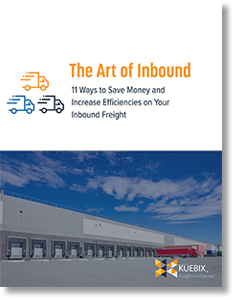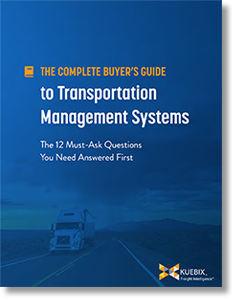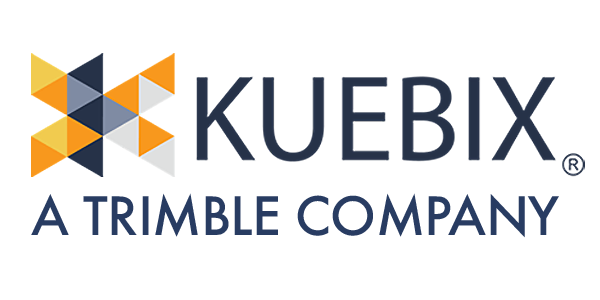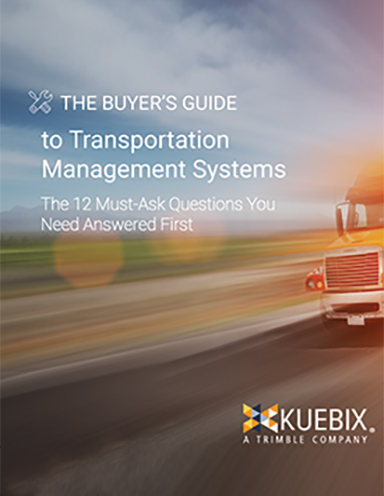How Food & Beverage Companies Can Optimize Their Inbound Freight Management Operations

Frequently overlooked and often pushed to the bottom of a shipper’s supply chain agenda, good inbound freight management can help companies improve shipment visibility, save money, and enhance customer service.
Food and beverage businesses have complex supply chains with many unique characteristics: ever-changing customer tastes, tight margins on store shelves, fresh products that may spoil, expiration dates on products, and more.
Getting the right volume of products at the right time, and at the right location, is no easy task.
Visibility into and control of supply chain processes will allow food and beverage businesses to address these challenges while meeting business goals.
Frequently overlooked and often pushed to the bottom of a shipper’s supply chain agenda, good inbound freight management can help companies improve shipment visibility, save money, and enhance customer service - all of which add to the bottom line and boost profitability.
Done right, inbound freight management does more than just help companies gain an understanding of where their shipments are in real time.
It also enables better relationships with carriers and suppliers for consolidation efforts, establishes routing guides that lead to much better dock efficiency, and empowers strategies for continuous improvement initiatives.
Food and beverage companies get dozens of deliveries a day from different suppliers.
These inbound shipments aren’t coordinated or consolidated, fostering inefficiencies in the excess number of deliveries. Little visibility into arrival times and frequent changes to inbound deliveries wreaks havoc at the dock and warehouse, which can make accessorial charges skyrocket and your inbound transport costs go off the charts.
Small to large food and beverage companies have found a Transportation Management System (TMS) to be the perfect tool for addressing the many challenges that come with managing inbound freight.
For example, one food retailer that operates over 200 stores across seven states had a couple hundred LTL deliveries per week, but by using Kuebix TMS, they were able to lower the number of deliveries to 20 or 30 per week by combining LTL deliveries into full truckload deliveries from the consolidation points. The typical cost for unloading a truck is $200, leading to approximately $34,000 in savings per week just on unloading costs!
Here are three steps you can take to start managing your inbound freight more effectively today:
1. Partner with your suppliers to lay out a plan of action
Determine the most cost-effective and efficient way to ship and unload your freight, and build a plan with your suppliers that benefits both parties. There is no “magic number” for a percentage of shipments that should be vendor-controlled vs. customer controlled. Give your suppliers a choice so that they can select the most effective service and billing procedure. Then, implement a standard routing guide for supplier compliance.
This will establish a set of mandatory guidelines that will be used for all vendor-controlled (VDS) and customer pick-up (CPU) shipments. Supplier compliance programs reduce your cost of goods by making your carriers and warehouse more efficient. In the event your suppliers fail to comply, they will share in your cost through violations outlined in the routing guide.
2. Create strong alliances with your carriers
Consolidate inbound shipments to full truckload wherever possible to reduce freight and unloading costs. Reducing the number of individual LTL shipments will decrease the cost of freight, dramatically increasing the efficiency of your distribution center and significantly reducing unloading costs. Think how much more efficient your operations will be with fewer trucks and fewer deliveries. For example, unloading 10 to 14 different LTL shipments can be five times the cost of unloading a single truckload. The customer and the supplier can share all of these savings through the efficiency of consolidated shipments and drop trailer programs.
By consolidating your LTL pool, you can simplify yard management and maximize consolidation opportunities. Select carriers that provide attractive rates and superior service and try to limit that set to two to four different carriers, whether the shipments are CPU or VDS. This will give each carrier enough business to ensure LTL consolidation does not affect service levels. Having a strong partnership with your carriers also opens up other opportunities for additional savings such as backhaul agreements with LTL carriers to consolidate freight to single truckload for pick up by your own fleet for the final mile.
3. Leverage technology to your advantage
Utilize a transportation management system (TMS) to maximize inbound freight management. For example, leverage your TMS to implement an allowance program for freight costs and unloading expenses with your suppliers. In most cases, allowances are negotiated once or twice a year and rarely take into account fluctuating costs and carrier rates. Oftentimes, market rates rise above negotiated rates. Kuebix TMS enables the creation of dynamic rate allowances to ensure savings on both TL and LTL shipments by calculating the best possible real-time vendor allowances based on actual carrier rates as demand dictates.
Additionally, a TMS will also automate tracking, scheduling, and door assigned, which will directly reduce your labor spend. Finally, if you cannot measure something it is hard to improve it. An effective TMS will capture every relevant piece of data and return reports, dashboards, and scorecards that allow you to analyze your inbound freight program and identify opportunities for increased efficiency.
Ultimately, good inbound freight management facilitated by technology helps shippers achieve cost and productivity goals that very often get overlooked in the logistics space.
By taking a step back and gaining a better understanding of your current inbound environment - then working with suppliers and carriers to come up with a plan of action to improve it - you’ll be able to leverage all of the market’s capacity, get the best rates, and gain better visibility over your end-to-end supply chain.
To learn more about optimizing your inbound download “The Art of the Inbound”.
Related White Papers & eBooks
The Art of the Inbound: 11 Ways to Improve Your Inbound Shipping Operations New!
This ebook provides a guide to benchmark your company against best practices in the transportation and shipping industry and helps to put together a strategic approach to capitalizing on the opportunities to manage the “art of the inbound.” Download Now!
The Complete Buyer’s Guide to Transportation Management Systems
There is almost no limit to how a Transportation Management System can benefit your unique supply chain, but the key to success is finding the right one for your goals, so, before selecting a TMS, use the 12 questions in this buyer’s guide to find the best solution for your company. Download Now!
Effectively Managing Big Data in Your Supply Chain
In this white paper, we’ll explain what the term “big data” means to the typical supply chain, introduce effective strategies for managing and leveraging that data, show how one grocer is using predictive analytics to harness its own big data, and explain the “first steps” that companies need to take down the path to effective management of their big data. Download Now!
More Resources from Kuebix
Article Topics
Kuebix News & Resources
Visibility + TMS = A Winning Combination Trimble Placed in 2021 Gartner Magic Quadrant for Real-Time Transportation Visibility Platforms Kuebix Positioned Again as a Challenger in 2021 Gartner Magic Quadrant for TMS The Buyer’s Guide to Transportation Management Systems TMS Update: Adoption accelerates The Logistics of Valentine’s Day during COVID-19 Pandemic Research: Trends in the Supply Chain and Their Impact on the Transportation Management System Market More KuebixLatest in Transportation
Nissan Channels Tesla With Its Latest Manufacturing Process Why are Diesel Prices Climbing Back Over $4 a Gallon? Luxury Car Brands in Limbo After Chinese Company Violates Labor Laws The Three Biggest Challenges Facing Shippers and Carriers in 2024 Supply Chain Stability Index: “Tremendous Improvement” in 2023 Trucking Association CEO on New Biden Policy: ‘Entirely Unachievable’ Two Weeks After Baltimore, Another Cargo Ship Loses Power By Bridge More Transportation
















